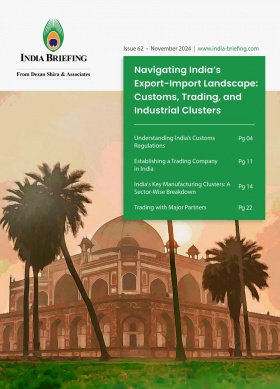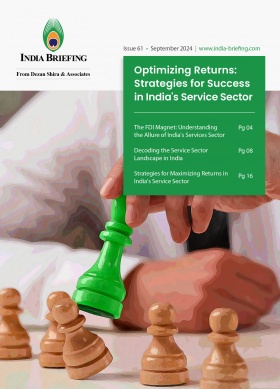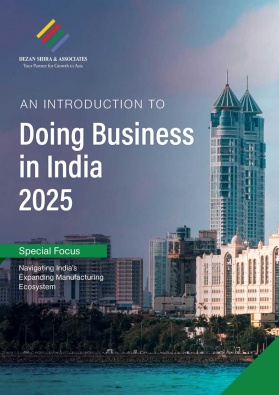India’s Medical Devices Industry: Investor Outlook
Over the past decade, India has evolved from a medical device market and research hub for multinational corporations into a prominent manufacturing center. Valued at US$12 billion in FY 2023-24, the sector’s growth is driven by strategic government initiatives, regulatory reforms, skilled engineering talent, and precision manufacturing capabilities.
Overview of India’s medical device industry
India’s medical device industry was valued at US$12 billion in FY 2023-24. According to a Mordor Intelligence report, India’s medical devices market size stands at US$16.97 billion in 2025 and is forecast to reach US$24.85 billion by 2030, reflecting a 7.93 percent CAGR over the period. The sector is a hub for innovation, attracting seed and venture capital funding.
India’s precision manufacturing sector has undergone notable advancements. Leveraging cutting-edge technologies like CNC machining, 3D printing, and robotics, domestic manufacturers now produce high-quality, precise, and reliable medical devices. Key domestic players such as Trivitron Healthcare (medical imaging) and Transasia Bio-Medicals (surgical instruments) compete with multinational giants like Philips and Siemens.
This progress is underpinned by a skilled workforce with expertise in advanced engineering and a robust ecosystem that includes state-of-the-art research and development facilities. Emphasis on stringent quality control measures and adherence to international standards has further enabled Indian manufacturers to meet the rigorous demands of global markets.
Key segments of India’s medical device industry
The medical devices sector plays a crucial role within India’s healthcare system, serving as a key component alongside healthcare providers, pharmaceuticals, and the health insurance industry. It supports the objectives outlined in the National Health Policy (NHP) 2017 by facilitating the prevention, diagnosis, treatment, and management of various medical conditions and disabilities.
The medical device sector is multi-disciplinary and broadly classified into five categories:
- Electronic equipment
- Implants
- Consumables and disposables
- Surgical instruments
- In-vitro diagnostic reagents
Many segments of the medical devices industry are highly capital-intensive, characterized by long gestation periods, continuous technological advancements, and the need for ongoing training for healthcare professionals to adapt to innovations. Additionally, stringent regulatory requirements mandate that medical devices must demonstrate safety, quality, and efficacy before entering the market. Moreover, despite India’s immense potential, per capita medical device spending remains low at just US$3, compared to the global average of US$47 and US$415 in the United States and US$313 in Germany.
India is home to over 800 small-scale medical device manufacturers, primarily focused on consumables and disposables. According to sector experts, Indian medical device makers have traditionally focused on low-cost, low-technology products such as consumables and disposables, with about 65 percent of manufacturers catering to local demand and having limited export capacity. In contrast, multinational companies (MNCs) dominate the high-technology segment, leveraging extensive service networks.
Nevertheless, India’s emergence as a global medical device manufacturing hub post-COVID-19 is noteworthy, driven by the growing involvement of large Indian conglomerates. Traditionally focused on sectors like automotive, aerospace, and electronics, these corporate giants have leveraged their resources and technological expertise to diversify into medical materials, a critical component of device production. This strategic shift has enhanced sector capabilities, fostering innovation and creating a transformative ecosystem for medical device manufacturing and exports.
Trade data from April–October 2024 shows a 5.74 percent year-on-year increase in India’s medical device exports, with the exports of optical, medical, and surgical instruments rising from US$2,214.67 million to US$2,341.72 million.
The global medical devices market size, valued at US$542.21 billion in 2024, is projected to grow from US$572.31 billion in 2025 to US$886.68 billion by 2032, exhibiting a CAGR of 6.5 percent during the forecast period. The United States (US), Europe, and Japan dominate the market, contributing 40 percent, 25 percent, and 15 percent, respectively. Meanwhile, emerging markets such as Thailand, Brazil, and China are experiencing rapid growth, with China’s sector expanding at an annual rate of over 20 percent.
|
India’s Exports of Optical, Medical, and Surgical Instruments (Value in US$ Million) |
|||
|
Commodity classification |
Apr-Oct 2023 |
Apr-Oct 2024(P) |
% growth |
|
Optical, medical & surgical instruments |
2,214.67 |
2,341.72 |
5.74 |
|
I1 Surgical |
405.75 |
427.83 |
5.44 |
|
K4 Optical items (including lens etc.) |
421.68 |
324.02 |
-23.16 |
|
M8 Medical and scientific instruments |
1,387.24 |
1,589.87 |
14.61 |
Source: System on Foreign Trade Performance Analysis (FTPA) Version 3.0, Department of Commerce
Top 10 medical device companies in India
- India Medtronic Private Limited
A subsidiary of Medtronic Plc, established in 1979, India Medtronic manufactures a wide range of innovative medical technologies such as cardiac devices (pacemakers, heart valves), neurostimulation systems, and minimally invasive surgical tools. - Johnson & Johnson Private Limited
International brand J&J manufactures range of medical devices across surgery, orthopedics, and cardiology. - Abbott India Limited
The company founded in 1910, Abbott India specializes in medical devices for diagnostics (blood glucose monitors, immunoassays), diabetes management, and cardiovascular care. - Siemens Healthcare Private Limited
Established in 1984, Siemens Healthcare manufactures advanced imaging technologies (X-ray, CT, MRI), laboratory diagnostics, and cancer care solutions. - GE Healthcare Private Limited
Wipro GE Healthcare, a joint venture established in 1990, offers advanced medical solutions in imaging, patient monitoring, and ultrasound. - DHR Holding India Private Limited
Operating since 1997, DHR Holding distributes diverse medical devices and laboratory equipment, including blood glucose monitors, dental tools, and clinical instruments. - 3M India Limited
3M India produces advanced medical solutions such as surgical drapes, sterilization wraps, and wound care dressings. - Baxter India Private Limited
A subsidiary of Baxter International, operating in India since 1996, Baxter supplies life-saving devices for critical care, renal care, and surgical needs. They also produce key medical products, such as infusion pumps and dialysis machines. - Stryker India Private Limited
International manufacturer Stryker entered India in 1999, and has since manufactured wide range of medical devices, including orthopedic implants, endoscopy equipment, and navigation systems. - B. Braun Medical India Private Limited
The company has been operations in India since 1984, and currently B. Braun delivers over 5,000 products, including infusion systems, catheters, and dialysis equipment.
India’s cost advantage and policy support
India’s cost advantage has played a pivotal role in its ascent, driven by factors such as competitive labor costs, engineering expertise, and modernizing supply chains. Initiatives by policymakers like the “Make in India” campaign, launched in 2014, have been instrumental in fostering a favorable environment for manufacturing. This program encourages both domestic and international companies to set up operations in India, driving investment and innovation.
Additionally, policies such as the Medical Device Rules (MDR) 2017 have established a robust regulatory framework that aligns with global standards, ensuring the quality and safety of medical devices. Dedicated MedTech zones and clusters, equipped with cutting-edge infrastructure, have further accelerated the growth of the sector by providing manufacturing facilities, research centers, and testing laboratories.
The Production-Linked Incentive (PLI) scheme has been another crucial initiative, designed to boost domestic manufacturing and attract investment in the medical device sector. India allows 100 percent foreign direct investment (FDI) into its medical devices sector.
Similarly, the National Medical Device Policy 2023 offers a comprehensive framework to support the industry’s growth and development.
Encouraging private sector participation through PLI scheme
On February 11, 2021, under the PLI scheme, the central government approved nine major projects, including those by Siemens Healthcare, Wipro GE Healthcare, and Sahajanand Medical Technologies, with a combined investment commitment of INR 7.29 billion (US$84.8 million). These projects are expected to create 2,300 jobs and enhance India’s domestic manufacturing capabilities.
To promote domestic manufacturing, India launched the PLI scheme for medical devices, with a total fund allocation of INR 34.2 billion (US$398.1 million) for FY21–FY28. By October 2021, 13 companies had been approved under the scheme. Additionally, a broader PLI scheme for pharmaceuticals worth INR 150 billion (US$1.74 billion) was introduced in March 2021 to enhance production and investment across the pharmaceutical and medical device sectors, ensuring affordable medicines for consumers.
India’s definition of medical devices
In India, medical devices are governed under the Drugs & Cosmetics Act, 1940, and the Medical Devices Rules, 2017.
Medical devices encompass instruments, apparatus, appliances, implants, materials, or other articles, including software or accessories, intended for human or animal use. These devices do not primarily function through pharmacological, immunological, or metabolic means but may support their intended use for purposes such as:
- Diagnosis, prevention, monitoring, treatment, or alleviation of diseases or disorders
- Diagnosis, monitoring, treatment, or assistance for injuries or disabilities
- Investigation, replacement, modification, or support of anatomical or physiological processes
- Life support or sustenance
- Disinfection of medical devices
- Contraception control
Risk-based classification of medical devices
Medical devices are categorized based on risk levels as specified in Part I of the First Schedule of the Medical Devices Rules, 2017:
- Class A: Low risk
- Class B: Low-moderate risk
- Class C: Moderate-high risk
- Class D: High risk
India’s medical device clusters and parks
According to a survey report published by the Ministry of Chemicals & Fertilizers in February 2023, India has 21 medical device clusters across nine states, with Uttar Pradesh leading with 6 clusters, followed by Maharashtra and Haryana with 4 clusters each. These clusters are established to reduce production costs and foster domestic manufacturing.
|
Medical Device Manufacturing Clusters in India |
||||
|
Sl. No. |
State/UT |
Region |
Number of medical devices clusters |
Share of medical devices clusters (%) |
|
1 |
Uttar Pradesh |
· Agra · Noida, Gautam Buddha Nagar · Sahibabad, Ghaziabad · Kanpur · Lucknow · Meerut |
6 |
29 |
|
2 |
Maharashtra |
· Ambarnath, Pune · Satpur, Nashik · Sinnar, Nashik · Bhiwandi |
4 |
19 |
|
3 |
Haryana |
· Faridabad · Karnal · Bhiwani · Gurugram |
4 |
19 |
|
4 |
Karnataka |
· Bengaluru · Mysuru |
2 |
10 |
|
5 |
Andhra Pradesh |
· Visakhapatnam |
1 |
5 |
|
6 |
Gujarat |
· Lodhika |
1 |
5 |
|
7 |
Rajasthan |
· Jodhpur |
1 |
5 |
|
8 |
Tamil Nadu |
· Chennai |
1 |
5 |
|
9 |
Telangana |
· Hyderabad |
1 |
5 |
|
|
Total |
|
21 |
100 |
Source: Field Survey by CMRSD
The Indian government’s survey report, compiled by Centre for Market Research & Social Development (CMRSD), reveals that India has a total of 736 operational industries within these clusters, averaging 35 units per cluster. Key hubs include Gurugram and Bhiwani in Haryana, Kanpur in Uttar Pradesh, and Hyderabad in Telangana.
Establishment of medical device parks
India has sanctioned multiple medical device parks to enhance infrastructure and attract investment:
- Himachal Pradesh: In July 2024, the Himachal Pradesh state government announced its plan to independently develop INR 30 billion (US$349.2 million) medical device park in Nalagarh, Solan district.
- Tamil Nadu: A 350-acre medical devices park is being set up at the SIPCOT industrial complex at Oragadam in Kancheepuram district with a potential to attract INR 35 billion (US$ million 407.4 million) in investments.
- Uttar Pradesh: An INR 5 billion (US$58.2 million) park announced in July 2021, anticipated to boost the state’s medical device industry. In May 2023, it was reported that as many as 59 companies have been allotted land in the upcoming medical device park near Noida and these firms would invest around INR 4.15 billion (US$48.3 million) in setting up their businesses.
Survey insights on medical device clusters
The 2023 CMRSD survey outcome notes India’s medical device manufacturing clusters encompass a range of industry sizes: 20 percent are micro-industries (147 units), 31.1 percent are small (229 units), 38.6 percent are medium (284 units), and 10.3 percent are large-scale industries (76 units).
Most clusters are equipped with essential infrastructure, such as testing and prototyping facilities, warehousing, accreditation labs, regulatory awareness hubs, and training centers. However, the lack of Special Purpose Vehicles (SPVs) and Common Logistics Centers have been identified as a bottleneck, impeding the growth of domestic manufacturing capabilities within the sector.
Medical device clusters’ production and export performance
As per the 2023 CMRSD survey findings, the collective output from the clusters is valued at approximately US$5,985 million annually, with domestic production accounting for US$3,250 million. A total of 126 export-oriented industries operates across these clusters, serving key markets like the USA, Germany, China, France, Singapore, and the UAE.
India’s medical device exports have shown consistent growth over the past five years, as reported by the Engineering Export Promotion Council (EEPC). Export figures have risen from US$1,868.05 million in FY 2017–18 to US$2,923.16 million in FY 2021–22, marking a compound annual growth rate (CAGR) of 12.05 percent.
(US$1 = INR 85.89)
(This article was originally published on January 10, 2025. It was updated on September 29, 2025.)
About Us
India Briefing is one of five regional publications under the Asia Briefing brand. It is supported by Dezan Shira & Associates, a pan-Asia, multi-disciplinary professional services firm that assists foreign investors throughout Asia, including through offices in Delhi, Mumbai, and Bengaluru in India. Readers may write to india@dezshira.com for support on doing business in India. For a complimentary subscription to India Briefing’s content products, please click here.
Dezan Shira & Associates also maintains offices or has alliance partners assisting foreign investors in China, Hong Kong SAR, Dubai (UAE), Indonesia, Singapore, Vietnam, Philippines, Malaysia, Thailand, Bangladesh, Italy, Germany, the United States, and Australia.
- Previous Article NSO Projects 6.4% GDP Growth for India in FY 2024-25 amid Sectoral Challenges
- Next Article BIS Certification in India: A Brief Primer







